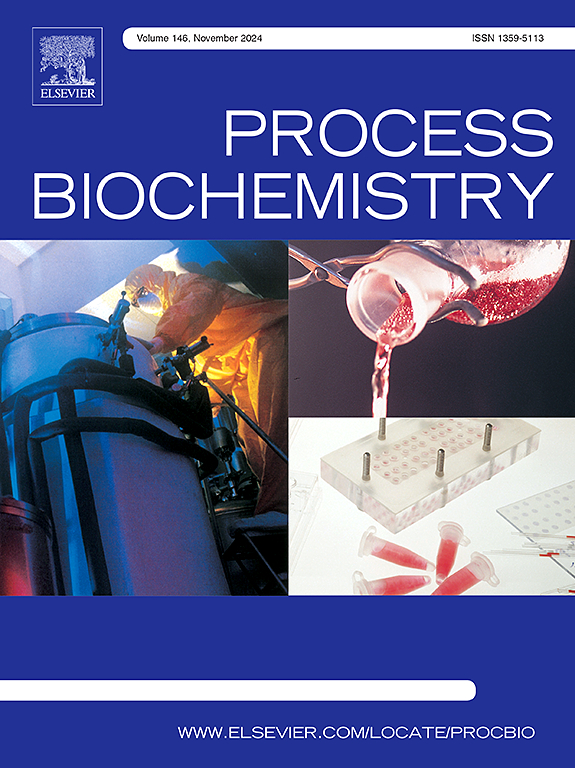Optimized production, purification and biochemical characterization of a novel glycerophosphodiesterase from a hyperthermophilic archaeon Pyrococcus abyssi
IF 4
3区 生物学
Q2 BIOCHEMISTRY & MOLECULAR BIOLOGY
引用次数: 0
Abstract
Organophosphate (OP) based pesticides, insecticides and nerve agents can cause nervous, respiratory, reproductive and hepatic problems in living organisms by serving as inhibitors of acetylcholinesterase. Recently, glycerophosphodiesterases (GDPDs) emerged as useful tools in degradation of organophosphate containing pesticides and nerve agents. The present work aims at recombinant production of a thermostable GDPD from Pyrococcus abyssi (Pa-GDPD) in E. coli under optimized cultural conditions. The actual molecular weight of the soluble recombinant enzyme was estimated to be ∼45 kDa with the help of gel filtration chromatography. Moreover, the optimum temperature and pH for Pa-GDPD’s activity were found to be 70 °C and 7.0, respectively. Activity of Pa-GDPD was found to be stimulated by Mn2 + followed by Fe2+ and Mg2+. The recombinant enzyme exhibited its hydrolytic activity towards glycerophosphodiester as well as bis (p-nitrophenyl) phosphate (BpNPP) at elevated temperatures (50–90 °C). Km, Vmax and Kcat for BpNPP hydrolysis were determined to be 1 ± 0.145 mM, 88 ± 2.538 U/mg and 2.654 103 min−1, respectively. Thermoactivity, broad substrate spectrum and stability in organic solvents make recombinant Pa-GDPD an ideal candidate for organophosphate bioremediation.
一种新型甘油磷酸二酯酶的优化生产、纯化和生化表征
有机磷农药、杀虫剂和神经毒剂可作为乙酰胆碱酯酶抑制剂,引起生物体的神经、呼吸、生殖和肝脏问题。近年来,甘油磷酸二酯酶(GDPDs)成为降解含有机磷农药和神经毒剂的有用工具。本研究的目的是在优化的培养条件下,在大肠杆菌中重组阿比西布焦球菌(Pa-GDPD)生产耐热GDPD。通过凝胶过滤层析,估计可溶性重组酶的实际分子量为~ 45 kDa。此外,Pa-GDPD活性的最佳温度和pH分别为70℃和7.0℃。Pa-GDPD的活性被Mn2 +刺激,其次是Fe2+和Mg2+。重组酶在50 ~ 90℃的高温下对甘油磷酸二酯和双(对硝基苯基)磷酸(BpNPP)具有水解活性。测定BpNPP水解Km、Vmax和Kcat分别为1 ± 0.145 mM、88 ± 2.538 U/mg和2.654 × 103 min−1。热活性、广泛的底物光谱和在有机溶剂中的稳定性使重组Pa-GDPD成为有机磷酸盐生物修复的理想候选者。
本文章由计算机程序翻译,如有差异,请以英文原文为准。
求助全文
约1分钟内获得全文
求助全文
来源期刊

Process Biochemistry
生物-工程:化工
CiteScore
8.30
自引率
4.50%
发文量
374
审稿时长
53 days
期刊介绍:
Process Biochemistry is an application-orientated research journal devoted to reporting advances with originality and novelty, in the science and technology of the processes involving bioactive molecules and living organisms. These processes concern the production of useful metabolites or materials, or the removal of toxic compounds using tools and methods of current biology and engineering. Its main areas of interest include novel bioprocesses and enabling technologies (such as nanobiotechnology, tissue engineering, directed evolution, metabolic engineering, systems biology, and synthetic biology) applicable in food (nutraceutical), healthcare (medical, pharmaceutical, cosmetic), energy (biofuels), environmental, and biorefinery industries and their underlying biological and engineering principles.
 求助内容:
求助内容: 应助结果提醒方式:
应助结果提醒方式:


